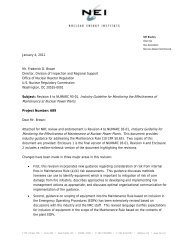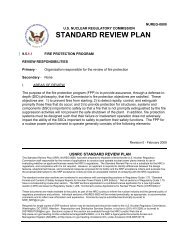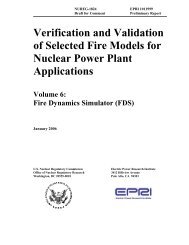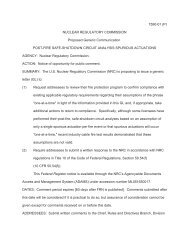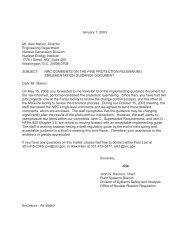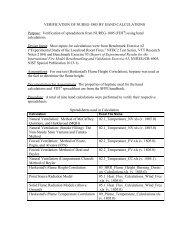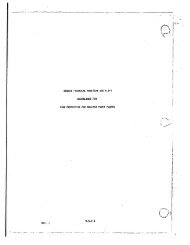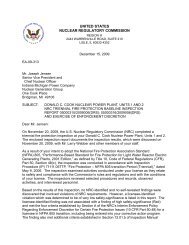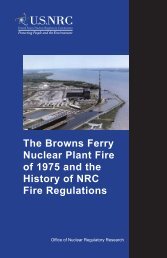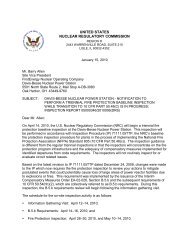NUREG/CR-6850, Volume 1 - NRC
NUREG/CR-6850, Volume 1 - NRC
NUREG/CR-6850, Volume 1 - NRC
Create successful ePaper yourself
Turn your PDF publications into a flip-book with our unique Google optimized e-Paper software.
1INTRODUCTION1.1 BackgroundOver the past decade, there has been a considerable movement in the nuclear power industryfrom prescriptive rules and practices towards broadened use of risk information to supplementdecision-making. In the area of fire protection, this movement is evidenced by numerousinitiatives by the U.S. Nuclear Regulatory Commission (<strong>NRC</strong>) and the nuclear communityworldwide. In 2001, the National Fire Protection Association (NFPA) completed thedevelopment of NFPA 805, “Performance-Based Standard for Fire Protection for Light WaterReactor Electric Generating Plants 2001 Edition” [1.1]. Effective July 16, 2004, the <strong>NRC</strong>amended its fire protection requirements to permit existing reactor licensees to voluntarilyadopt fire protection requirements contained in NFPA 805 as an alternative to the existingdeterministic fire protection requirements [1.2]. In addition, there is significant recent emphasison risk-informed decision-making under the current 10 CFR 50 Appendix R rule [1.3]concerning changes to the plant’s fire protection licensing basis, requests for exemptionor deviation, and the evaluation of inspection findings.During the 1990s, both the <strong>NRC</strong> Office of Nuclear Regulatory Research (RES) and theElectric Power Research Institute (EPRI) were active in the development of methods for fire riskanalysis. EPRI, in particular, developed methods to support its utility members in the preparationof responses to Generic Letter 88-20, Supplement 4, Individual Plant Examination of ExternalEvents (IPEEE). This effort produced the Fire Induced Vulnerability Evaluation (FIVE)Method [1.4] and the Fire PRA Implementation Guide [1.5]. FIVE was reviewed by the <strong>NRC</strong>and approved (with certain conditions [1.6]) for use in the IPEEE program. The Fire PRAImplementation Guide was reviewed by the <strong>NRC</strong> during the IPEEE process and, followingresolution of several issues, was ultimately accepted by <strong>NRC</strong> as meeting the IPEEE goals.Virtually every U.S. nuclear utility used one or both of these documents to perform their IPEEEfire analyses. However, in a broader context (i.e., for applications beyond the IPEEE process), acomprehensive effort to resolve comments and concerns was still needed. As a result of <strong>NRC</strong>’sreview of licensee submittals and based on their experience with the IPEEE program, the <strong>NRC</strong>raised a number of technical issues regarding FIVE and the Fire PRA Implementation Guide[1.5]. While the applied methods were deemed acceptable for accomplishing the objectives ofthe IPEEE, it became clear that they would need upgrades to support future Risk-Informed/Performance-Based (RI/PB) applications in fire protection.1-1





